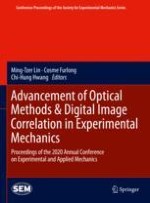2021 | Buch
Advancement of Optical Methods & Digital Image Correlation in Experimental Mechanics
Proceedings of the 2020 Annual Conference on Experimental and Applied Mechanics
herausgegeben von: Prof. Ming-Tzer Lin, Prof. Cosme Furlong, Chi-Hung Hwang
Verlag: Springer International Publishing
Buchreihe : Conference Proceedings of the Society for Experimental Mechanics Series
